Halong Bay in Vietnam is seriously stunning. But the word is well and truly out, and the environment is under pressure. So is it possible to explore this spectacular World Heritage area responsibly, and get away from the crowds at the same time? We find out on a Bai Tu Long Bay cruise.
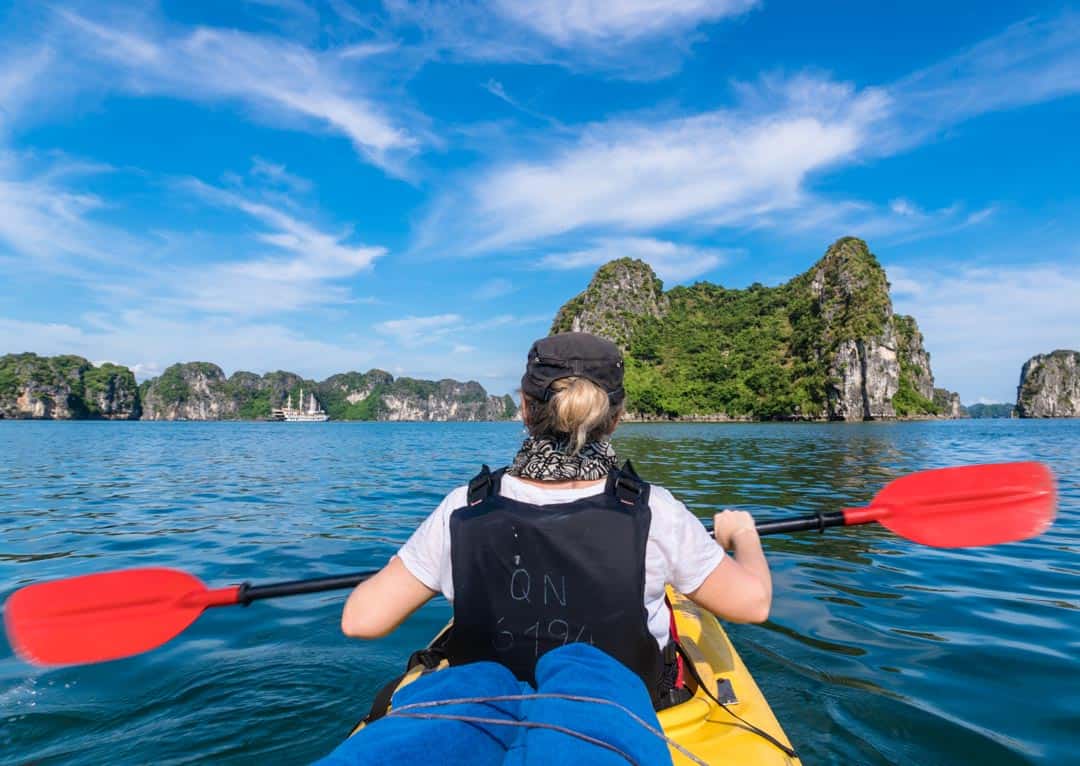
The port at Hong Gai on the coast of Halong Bay was teeming with people. Minivans convoyed into the small parking area, emptying carload after carload of tourists and bags.
Groups were herded down to a narrow pier, where little tender boats tootled back and forth, ferrying passengers to a fleet of painted white junks and cruise boats offshore.
Overhead, a cable car swayed on its journey from the base of an enormous ferris wheel to an amusement park in the distance, the largest in south-east Asia.
John and I glanced at each other, eyes wide. We were expecting busy. Cruising Halong Bay is top of the bucket list for just about everyone who visits northern Vietnam. But as we stood there watching the frenetic activity swirl around us, everything we’d read about the rising impacts of overtourism in this World Heritage destination suddenly seemed all too real.
Halong Bay: Legend And Fact
Legend tells how, in ancient times, an armada of warships bore down on the coast of a newly minted country called Vietnam.
The Emperor called forth the Mother Dragon and her children to protect the fledgling country. They destroyed the fleet by breathing a fire of jewels across the water. The gems transformed into thousands of rocky islands, a barrier into which the attacking fleet crashed and sank.
Halong means ‘descending dragon’, and it’s this folklore that gave Vietnam’s breathtaking gulf of limestone islands its name: Halong Bay.
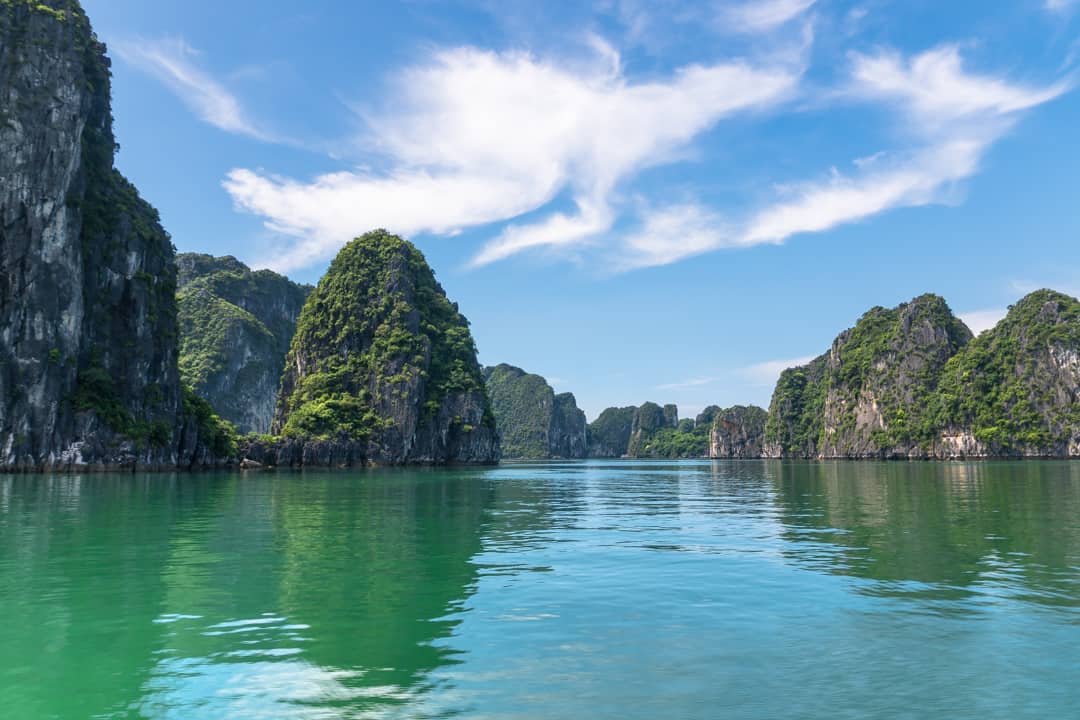
The story of the dragons might be myth, but there’s a very real armada posing a modern-day threat to the waters of Halong Bay: tourist boats.
Our First Halong Bay Cruise
John and I did our first Halong Bay cruise in 2004. As backpackers on a very short financial leash, we opted for the cheapest overnight junk we could find. And junk was what we got – a creaky, run down, mozzie den of a boat with a couple of cheap plastic chairs strewn about the upper deck. Bitey insects aside, we loved it.
Even back then though, Halong Bay was buzzing. Leaving port, we joined a cohort of other boats all plying the same route. Wedging into the dock for the climb to Sung Sot cave, we rubbed elbows with dozens of others on the stairs and looked out over a cove jammed with boats of all sizes.
That was nearly 15 years ago, and we’d heard plenty since about the decline of this extraordinary place, in a large part due to rapid growth with limited regulation and environmental protections.
But we were still curious. That first Halong Bay tour was accompanied by a mist so dense and persistent, we didn’t really feel like we’d seen the World Heritage gulf in all its glory.
Then we developed the two rolls of film that we’d shot (it was that long ago). When the photos came back, there were blue and red lines running right through the scenery. Every. Single. Photo.

So when we recently decided to visit northern Vietnam again, the question came up. Should we go back and do another Halong Bay cruise?
We didn’t want to become part of the problem. But we were keen to see this magical place again. More importantly, we wanted to find out whether there were ways to cruise Halong Bay responsibly, and off the beaten track.
Meet Bai Tu Long Bay, The Ideal Alternative To Halong Bay
Today, around 700 tourist boats cruise Halong Bay, ranging in size from intimate private yachts to ships sleeping hundreds. Apparently more than 90% of these boats sail a well-travelled route through the Gulf of Tonkin, following near identical itineraries.
A small percentage of boats, however, have permission to cruise to the further reaches of Halong Bay, and into a much larger, but less visited corner of the gulf called Bai Tu Long Bay. We decided that was where we wanted to go.
At first, we weren’t convinced. Researching Bai Tu Long Bay cruise options, we found that even there, the cookie-cutter itinerary was still at play. Whether this is a by-product of the regulations that do exist, or creativity stifled by stiff competition, we don’t know.
Ultimately though, we agreed a unique itinerary was less important to us than finding an operator with a policy of responsible tourism, and the reviews to back it up. We also wanted to kayak.
Finding The Treasure In The Junk
That’s when we hit upon Treasure Junk. A well-appointed wooden boat with just 15 cabins and a Bai Tu Long cruise itinerary, Treasure Junk first caught our eye with a practical, pointed statement on their website about what they’re doing to cruise responsibly.
We liked the fact they were honest about the scale and realities of the challenges facing Halong Bay, while rising to them with a focus on making their own activities environmentally-friendly, supporting local communities, organising annual clean-ups, and agitating for better practices across the industry.
After doing some more research on what others were saying about the experience, and ruling out a couple of competitors based on size and price, we signed up for Treasure Junk’s 3-Day/2-Night cruise.
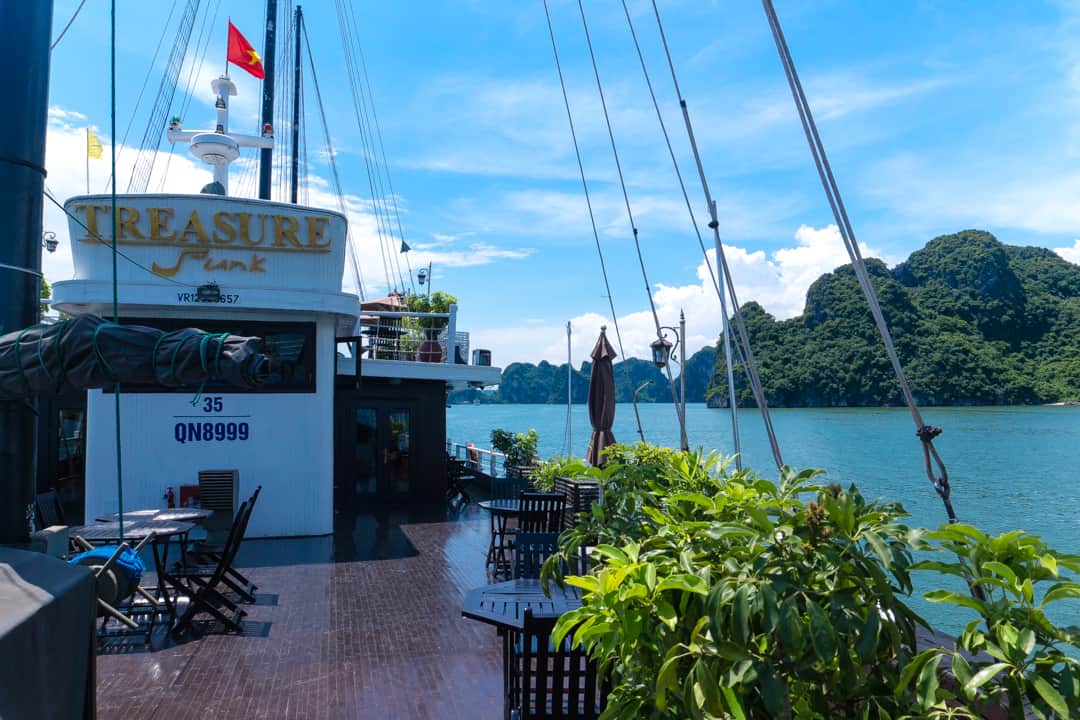
Our Bai Tu Long Bay Cruise Itinerary:
3 Days/2 Nights On Treasure Junk
Day 1 – Morning
Of course, it’s one thing to do your research for a trip, and quite another to experience it for yourself. We were still a little nervous about what we would find as we boarded the minibus for our journey from Hanoi to Halong Bay.
Most Halong Bay tours start from Hanoi, Vietnam’s vibrant capital. We’ve visited Hanoi several times, so on our most recent trip, we set out to find some of the city’s more offbeat experiences. Check out our post: A One-Day Off-The-Beaten-Path Hanoi Itinerary.
Our guide for the duration of the trip, Hoa, quickly put our fears at ease, talking us through the story and sustainable tourism focus of Treasure Junk’s parent company, Handspan, and his own experience working with them for the past two decades.
He filled much of our 3.5 hour drive with fascinating insights into Vietnamese history and culture, Halong Bay’s story, and the current situation facing the landscape and its floating village communities.
Travel Tip
Just about all Hanoi to Halong Bay transfers make a toilet stop en route at the Hong Ngoc Fine Art Centre, a huge workshop and factory selling all manner of art, textiles, sculptures and souvenirs at tourist-inflated prices.
Much of the art is created by talented people with disabilities, and you can see some of them at their craft onsite. There’s also a restaurant and a shop with pricey food and drinks.
There’s no pressure to buy, though you will be followed by attendants the moment you start browsing, so if you’re not interested, just use the (very clean) toilets and wait outside for your van or bus.
Day 1 – Afternoon
By early afternoon, we were aboard Treasure Junk and checked into our cute little cabin. There are doubles, twin cabins and a couple of suites on the Treasure Junk.We opted for a double with ensuite bathroom, which was cosy but had more than enough space for our backpacks.
With the stupendous views outside and the various activities planned, we didn’t plan on spending much time in our cabin anyway.

We were pleased to find a water cooler on the cabin deck, and glass bottles in our room which we could fill at the cooler whenever we needed.
Lunch was served as we started cruising Halong Bay, leaving the port city behind and heading east towards Bai Tu Long Bay. Soon enough we were passing clutches of the limestone pinnacles the bay is famous for.
The indoor dining area where we ate lunch was a beautiful dark wooden space in which we would go on to enjoy delicious multi-course meals over the next couple of days.
Vietnamese food is one of our fave cuisines in the world, and despite cooking for a crowd, brunches, lunches and dinners on the boat were top notch.
Ironically, the only meal we didn’t enjoy so much was the eggs-and-bacon Western style breakfast on Day 2. Give us Vietnamese pho for brekkie any day.
At 3pm, we gathered for a kayak briefing outside on the main deck, before setting off in double kayaks for a guided paddle on the bay.

This was the first real test of the Bai Tu Long cruise experience for us, and we were on the watch for crowds and rubbish.
Paddling for a little over an hour, we saw just one other group of kayakers and a single cruise boat.
We spotted a couple of bits of floating plastic, which we collected as we passed, a practice encouraged by the Treasure Junk crew. When we hauled out at a small beach, the crew immediately set about picking up bits of trash that had washed ashore.
The water looked clean and inviting, and several people went for a swim as we lazed on the beach.

So far, pretty darn good.
Day 1 – Evening
Back onboard and anchored for the night in Hang Ba cove, we showered and made our way up to the junk’s panoramic upper deck with an icy cold beer, just in time for a superb sunset.
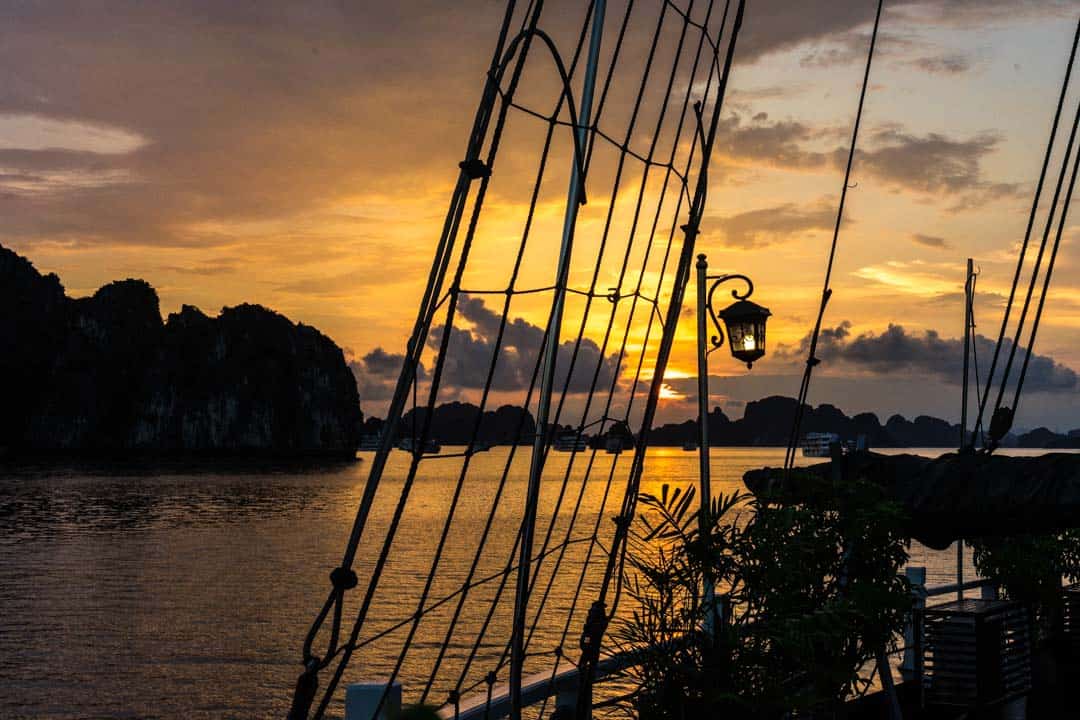
On Treasure Junk, as on just about every Halong Bay cruise itinerary, a cooking demo was set up on the main deck before dinner.
We popped by briefly for some spring roll instruction before returning to our favourite post at the bow to enjoy the twilight, and – to our dismay – watch as a conga line of other boats began to arrive in our little cove.
By the time dinner rolled around, we had 22 cruise boats for company. On querying it, Hoa explained that following some serious incidences in Halong Bay, safety regulations now require boats to dock together overnight in designated coves, for the safety of passengers and boats.
Fair enough. We could live with sharing a small space for the night. We figured (hoped?) with less boats in Bai Tu Long generally, the flotilla would disperse in the morning, and we’d go back to feeling like we had the place mostly to ourselves.

Post dinner, a squid fishing session was set up off Treasure Junk’s tender. I gave it a go. If you’ve ever ‘jikked’ for squid though, you’ll know that unless you have the patience of a saint, twitching a bamboo pole up and down in the hopes some unwitting future calamari latches on, is entertaining for all of three minutes.
Apparently the success rate is pretty low too, although we did hear some woots from the other boats in the cove, so maybe they had better luck.
Back in the indoor social area a film was screening, and a group had gathered over a board game in the corner. We took the opportunity to watch the starry skies from the top deck until they clouded over, then went to bed and set the alarm for dawn.
Day 2 – Morning
We were up with the dawn on Day 2 of our Bai Tu Long cruise. This is a perfect time of day on the bay, with mist swirling between the limestone islands and the first light of day casting a pale golden glow on the water.
While we practised our sunrise photography on the top deck (read ‘grappled with fogged up lenses’ – see below), others relaxed their minds and muscles with a pre-brekkie Tai Chi session on the main deck, another classic feature of the Halong Bay cruise.
Travel Tip – Beware The Lens Fog
There’s nothing quite as infuriating as getting up before dawn (especially when you’re a night owl), setting up your camera ready for a glorious sunrise, and finding your camera lens has fogged up.
We experienced this on both mornings of our cruise, the result of taking our cameras from our cool room into the humidity outside.
The lenses took ages to defog and lost us plenty of good shots. Given we were on a boat though and not inclined to leave our cameras outside, there wasn’t an awful lot we could do, apart from getting up earlier and waiting for the fog to clear.
With hindsight, we’d have tried some counter-measures, like sealing the cameras in ziplock bags.
Brekkie is served from 7.15am on Treasure Junk on Day 2 of our itinerary, but there’s coffee and tea on the go from 6.30am, so once we’d managed to snap off a couple of shots, we took our coffees and went back out on deck to enjoy the early morning serenity.
Like many Halong Bay cruises, Treasure Junk offers both 1- and 2-night trips on the same boat. So every day, the boat heads back to port to swap out its passengers. Fortunately, if you’re doing a 2-night cruise, as we did, you don’t have to go back with the boat. Instead, you’ll transfer to a smaller vessel for the day and stay in Bai Tu Long.
Our day boat, the Du Lich, was a cute and creaky old junk, perfectly suitable for the six of us sticking around for another day’s exploring Bai Tu Long Bay.
Our first stop of the morning was Co Cave, a pretty little grotto high up in a limestone island, with nice stalactites and stalagmites.
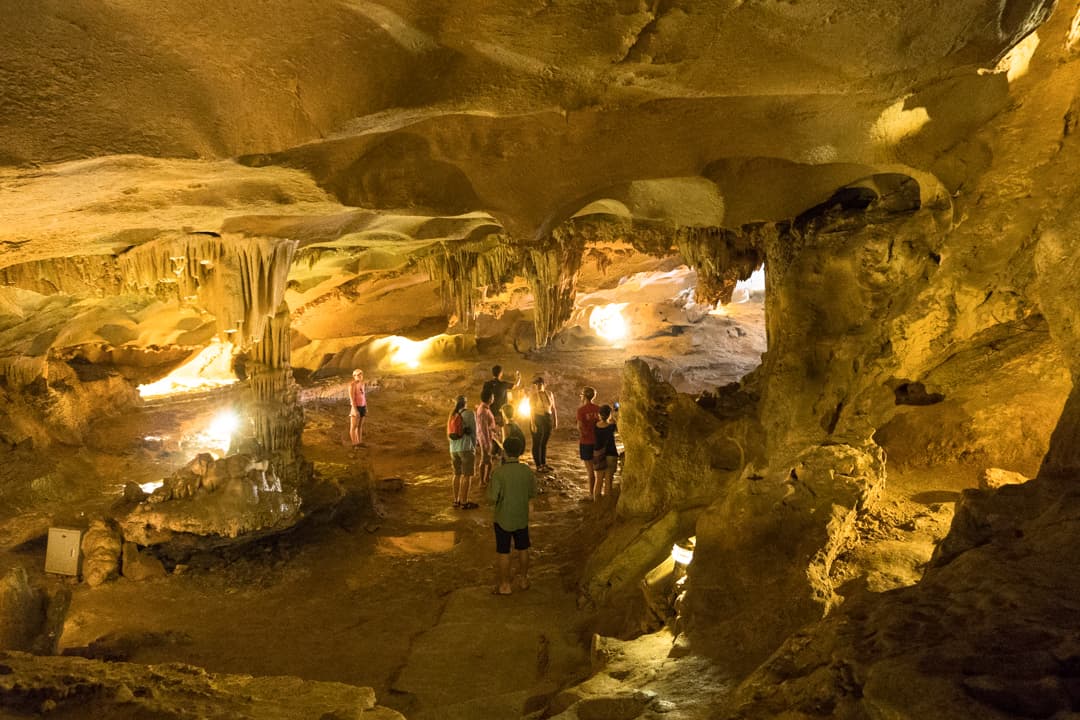
From the cave, we cruised for around 45 minutes until we reached a floating village offering kayak hire. Kayaking is one of the most popular things to do in Halong Bay as well as Bai Tu Long, and one of the perks of a 2-night cruise is being able to get out for a paddle a couple of times over the trip.
Over the next hour and a half, we kayaked around stunning pinnacles, stopped to chat with local fishermen, and drifted into the narrow, water-smoothed crevasses of two small islands. It was scorching hot but serenely gorgeous and, again, we saw just one other group of kayakers all morning.

Day 2 – Afternoon
After relaxing for a while on a small beach and kayaking back to the Du Lich, we enjoyed a tasty lunch before chilling in the breeze on the boat’s top deck.
Around 3pm, we made our way back to the Treasure Junk, which had returned to Bai Tu Long Bay with its latest passengers.
We’d lucked out with a glorious day of blue skies and sunshine, but storms can brew quickly in the low season (we visited in August). After showering and settling in for sunset with beers in the bow, we watched mesmerised as dark storm clouds, lit up with a golden sunset glow, gathered on the horizon. It was a spectacular finish to the day.
Then the skies opened up.
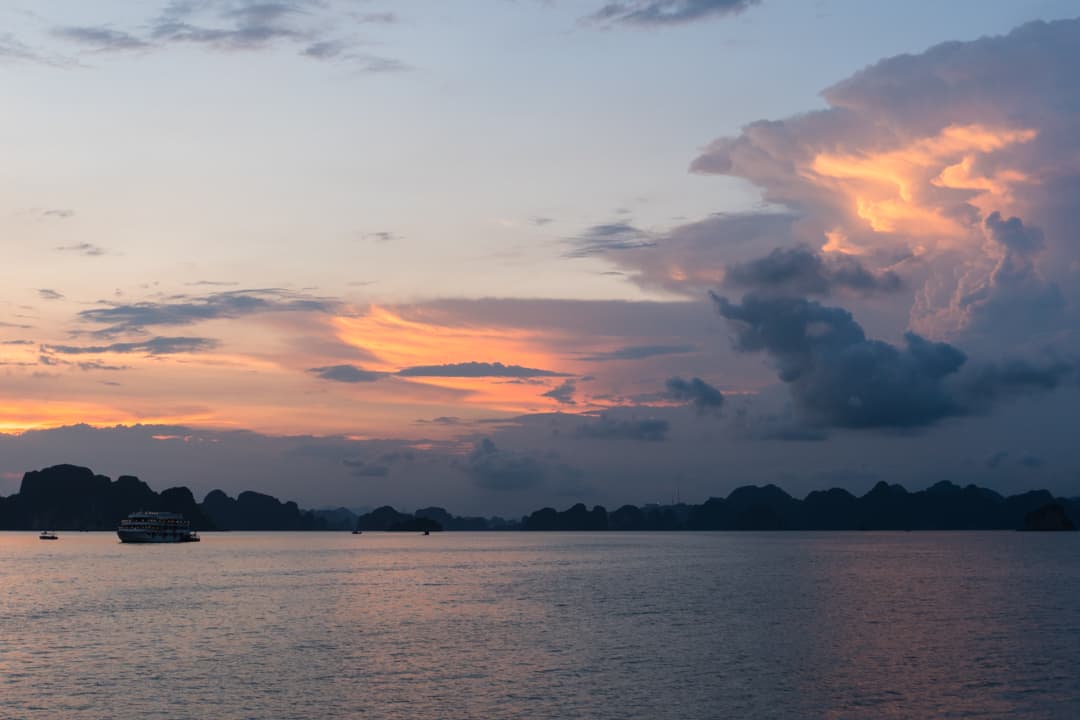
Travel Tip: Best Time To Visit Halong Bay & Bai Tu Long Bay
You can visit Halong and Bai Tu Long pretty much year-round, though the cooler months of Spring (March to May) and Autumn (September to November) are said to be the best.
Our first visit was in April, and we had mist and rain for most of the overnight cruise.
Our most recent trip was in August which, along with June and July, is low season. Storms are more likely over this period, so if you’re on limited time, check with your chosen cruise operator about what happens in the event of a cancellation.
We lucked out on the weather front, with blue skies for most of our trip, though we did have a spectacular rain storm on our second night. It had cleared by morning. Roll the dice, this place is beautiful in all weather.
Day 2 – Evening
Starry skies or driving rain, this corner of the world is spectacular either way, and we soon succumbed to the urge to head back outside. We parked under cover with a bottle of wine as darkness fell, watching as the expected parade of boats cruised into our cove – a different one this evening – and dropped anchor for the night.
We joined in the cooking demo on our second evening, trying our hand at making fried betel leaf with pork and mushroom. We both agreed we were far better at eating it.
With a day of kayaking, swimming, wandering caves and relaxing in the sun behind us, we opted out of the evening film again after dinner, in favour of another early night.
Day 3 – Final Morning
Our final morning on Treasure Junk found us on deck at sunrise once more. We skipped the Tai Chi session again though and left others to perform the slow movements while we amped up on caffeine. It really did look quite zen, but well, coffee.
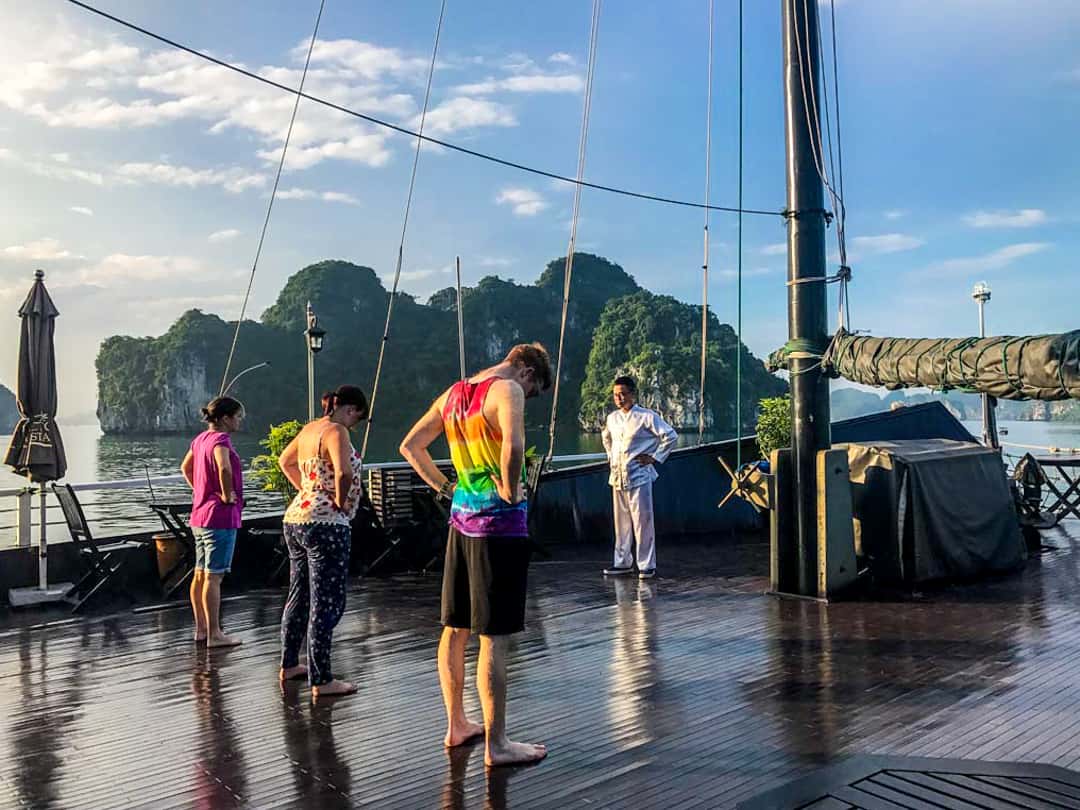
Around 7.15am, we boarded the little tender and made our way to the floating village of Cap La.
There, we transferred to small, traditional bamboo boats rowed by locals for a tour out to a stunning limestone arch. Alas, the view through the span wasn’t quite so appealing, with a huge oil tanker dominating the scene.
Credit to the local people rowing the boats though – hard yakka! Tips are appreciated. We say they’re well earned.
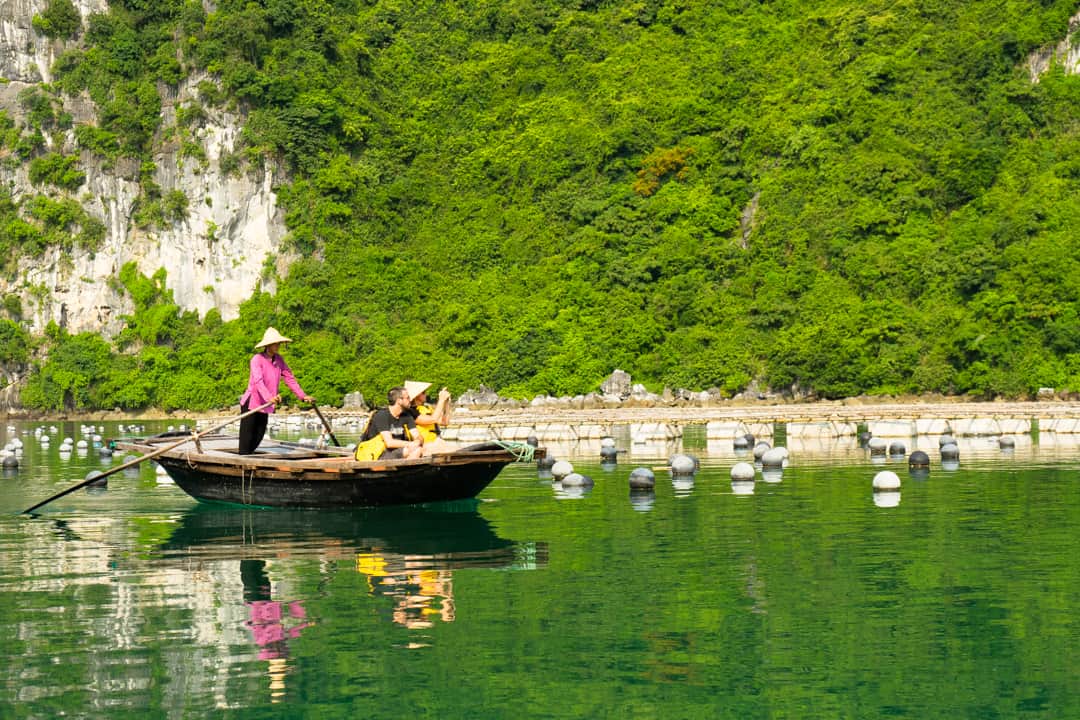
Back at the floating village, we were taken on a quick tour through a pearl farm and workshop.
The practice of pearl cultivating is a local tradition, and visiting a pearl farm is one the most popular things to do in Halong Bay (it was certainly the busiest stop on our cruise). For us though, there was a touch of the tourist trap about it, especially when we were led into a shop selling pearl jewellery at the end of the tour.
Not being in the market for pearls, we simply made our way through to the exit and hung out with the floating village dogs until our group was done.

While the floating village houses we passed were highly photogenic, with hindsight, we would probably skip the activities on the final morning and simply enjoy our last hours in Bai Tu Long Bay, with Vietnamese coffee and those views.
Back aboard the Treasure Junk, packed and checked out, we sat down to a hearty final brunch as we farewelled Bai Tu Long and began the cruise back into Halong Bay.
By midday, we’d left the serenity of the islands well behind and were on the road back from Halong Bay to Hanoi, arriving around 4pm.
Travel Takeout
While all meals were included in our cruise cost, along with pot coffee, tea and water, other bevvies like booze and Vietnamese coffee were extra.
We had a tab during our trip, and sorted out the bill on the last morning. Drinks are charged in US dollars and you can pay by credit card. The exchange rate onboard was steep though, so be prepared if you’re paying in Vietnamese dong.
Did We Find What We Were Looking For In Bai Tu Long Bay?
Yes! While the crowds and pollution at the port in Halong City had us seriously concerned at first, once we’d left the fleet behind and made our way into the waters of Bai Tu Long Bay, we genuinely felt as though we were off the beaten track. Until evenings anyway, when all the boats in the area gathered for safety reasons.
We were happy to find very little rubbish in the waters we cruised, kayaked and swam, and we particularly liked that the company we travelled with made a point of collecting it, and encouraging us to collect it too.

That’s not to say there isn’t a more insidious pollution in Halong Bay. With literally thousands of tourists taking to these waters every day, and limited broad-scale environmental policy and regulation, rubbish and waste water pollution from tourist boats is a very real threat to this World Heritage gem.
However, there are organisations working hard for industry-wide change, and as travellers, these are the organisations we should be supporting.
So Is Halong Bay Worth It?
The Halong Bay World Heritage Area is one of the planet’s outstanding natural landscapes; it’s a place absolutely worth visiting.
For the sake of the environment though, if you want to see it, we highly recommend going with a responsible operator that actively cares about the protection of this beautiful place.
And if you can, go for the Halong Bay alternative and visit waters less travelled on a Bai Tu Long Bay cruise. You’ll still be in the World Heritage area, and you’ll still be cruising Halong Bay to get to and from Bai Tu Long.
We’re 100% glad we returned; moreso that we found a corner that hasn’t been overrun by the tourist boat armada.
We hope it stays that way for Bai Tu Long Bay, and that the country finds the harmony between tourism and the environment, bringing in the right kinds of policies and protections – a modern Mother Dragon and her children – for the long-term future of Halong Bay.
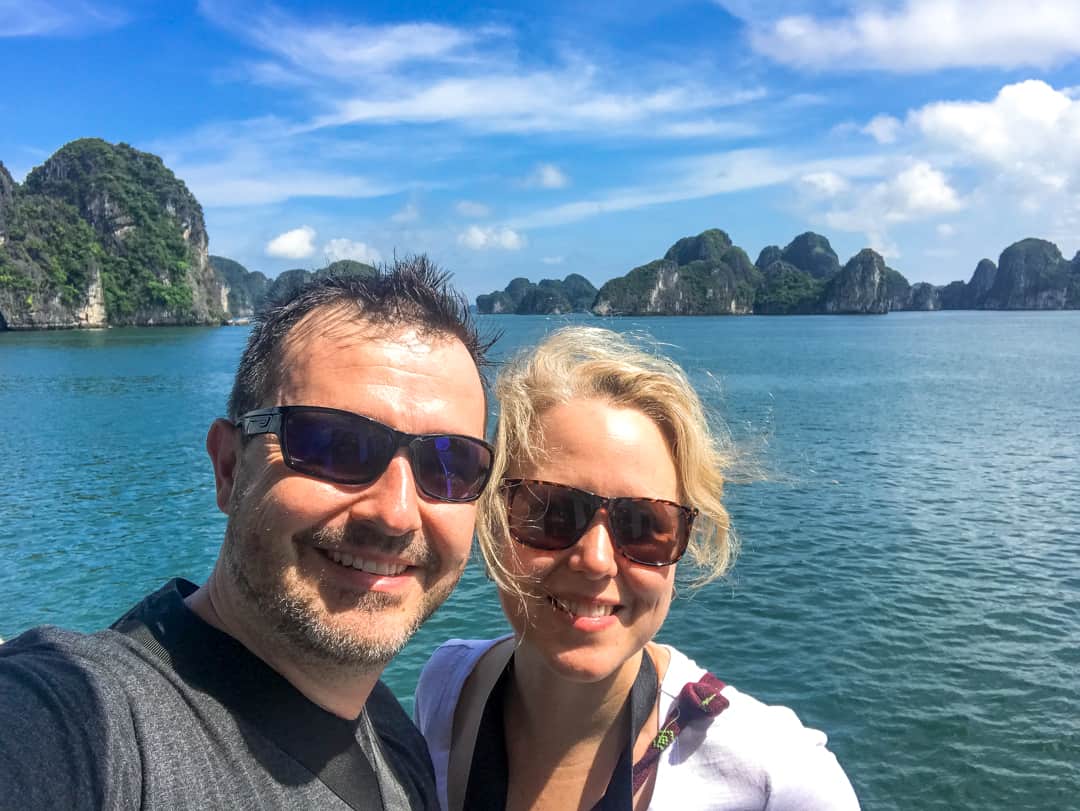
Have you been to Halong Bay or Bai Tu Long Bay? What was your experience? Let us know or ask us any questions you have in the comments below.

Thanks guys for the amazing read.
My wife and myself are planning our first trip to Vietnam South to North ( SE Asia being relatively affordable from Perth WA)
The whole Ha Long bay cruise part has been overwhelming for me.
We generally try to take the road less travelled where possible and attempt to get away from the masses of tourists (Pemberton & the South West WA is home so you get the idea about isolation 🙂 – and while Luxury is nice once in a while, sustainable tourism is far more important. So this is one of the first articles I’ve come across to mention that and its refreshing.
Hi Dave, thanks so much for your feedback, it’s much appreciated and we’re really pleased you’ve found our article helpful. It’s been a little bit since we did this trip but sustainable tourism is more important now than ever. We’re planning to return later this year so it will be interesting to see how things are faring. Happy planning and we hope you and your wife have a wonderful time in Vietnam; it’s one of our favourite countries! Cheers, Danielle & John
Hi, i have been searching about Bai tu long bay cruises, where did you buy it?
thanks!
Hi Paola, thanks for your message. We spent quite a bit of time researching companies running boat tours in Halong Bay and Bai Tu Long Bay as we were looking for a sustainable and responsible operator with solid reviews. The cruise we found is run by Handspan Travel Indochina and we contacted them directly via email (available via their website) to find out more and book. Happy trip planning and have a magic time in Vietnam!